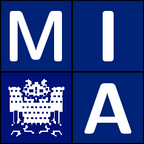
Welcome to the homepage of the lecture
Wavelets and Sparsity
Summer Term 2012
Home
About Us
People
Teaching
Research
Publications
Awards
Links
Contact
Internal
Wavelets and Sparsity
Lecturers:
Dr. Simon
Setzer and
Laurent
Hoeltgen
Office hours: TBA
Summer Term 2012
Lectures (3h) with exercises (1h)
(6 credit
points)
Time and Location: Tuesday 12-14 c.t. and Thursday 14-16 c.t.,
Building E1.3, Lecture Hall 001
First lecture: Tuesday, April 17, 2012
Exercises: Every second Thursday instead of a lecture, Laurent
Hoeltgen will present the solution to the exercises.
Announcements – Description – Prerequisites – Lecture Notes – Assignments – Exams – Registration Literature
Don't forget to schedule an appointment for your oral exam.
The wavelet transform allows us to represent data in a more suitable "basis". The resulting wavelet coefficients yield interesting ways to analyze and manipulate the data, e.g., compression (JPEG2000), multiscale analysis of seismic data, image denoising and inpainting. A central theme is that the given data is efficiently encoded in only relatively few wavelet coefficents ("sparsity"). We discuss not only the basic theory of the continuous and discrete wavelet transform but also algorithms and applications in image processing.
Undergraduate knowledge in mathematics (e.g. ''Mathematik für Informatiker I-III''). The lectures will be given in English.
Homework will be assigned bi-weekly. To qualify for the exam you need 50% of the points from these assignments.
There will be an oral or a written exam depending on the number of students.
The Registration for the lecture is currently open. Please register
here.
Remember that you also have to register for the exam in
the HISPOS system of the
Saarland University
No textbook is required for this course. Examples of books giving background material and further reading are:
- Sparse Image and Signal Processing: Wavelets, Curvelets,
Morphological Diversity
J.-L. Starck, F. Murtagh and J. M. Fadili, Cambridge University Press, 2010
- A wavelet tour of signal processing: the sparse way (second
edition)
S. G. Mallat, Academic Press, 2009
- Sparse and Redundant Representations
M. Elad, Springer, 2010
- Ten lectures on wavelets
I. Daubechies, SIAM, 2006
- Wavelets Theory and Application
A. K. Louis, P. Maaß and A. Rieder, J. Wiley & Sons, Inc., 1997
- Fourier Analysis and Applications
C. Gasquet and P. Witomski, Springer, 1998
MIA Group
©2001-2023
The author is not
responsible for
the content of
external pages.
Imprint -
Data protection